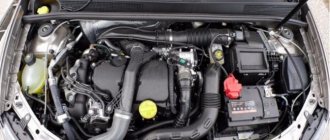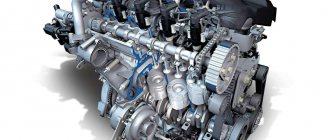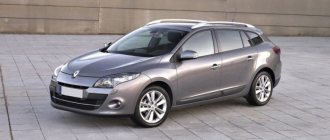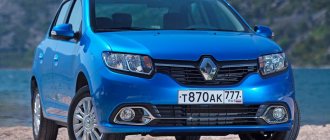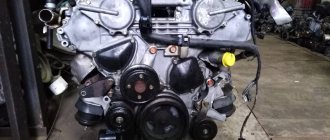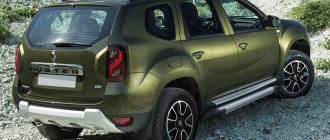Clio Renault Sport
Clio Renault Sport
Clio Renault Sport
Clio Renault Sport: 2.0 l, 203 hp, 215 Nm, M6, RUB 899,000.
Lap time: 1.57,4
The Mohicans, if anyone doesn’t remember, are a group of North American Indians whom the French colonists called “wolves.” The once powerful confederation, decimated by epidemics and wars, eventually ceased to exist, and the history of the extinction of the tribe was described by Fenimore Cooper in the novel “The Last of the Mohicans.”
So the Clio RS remained the only B-class “lighter” with a two-liter naturally aspirated engine producing 203 hp. Competitors are taking the path of reducing displacement and increasing output using supercharging - like the 192-horsepower Corsa OPC with a 1.6-liter turbo engine or the Volkswagen hot family, where 180 “horses” are removed from 1.4 liters using a combination mechanical supercharger and turbo.
tachometer
The yellow tachometer scale reminds you that it is the main device here.
A sound signal and a flashing light will help you switch in time. The yellow tachometer scale reminds you that it is the main device here. A sound signal and a flashing light will help you switch in time.
But atmospheric is a special, unique thrill! Modern supercharged engines, for the sake of ecology and ease of control, are practically devoid of turbo lag and, despite their modest volume, they pull hard almost from idle. And here the cubic capacity, it would seem, is solid, but no - at minimum speeds the engine choke, at medium speeds it works routinely, and at high speeds... These are all the signs of a highly accelerated racing engine! Picking up after five thousand, the flash of the tachometer needle, which has slipped about... A flash of “shift light”, an indicator of optimal shifting, and a sound signal - following the precise movement of a convenient lever, the first stage is quickly but gently replaced by the second. A harsh clutch pedal with a closing moment “smeared” throughout its travel turns out to be excellent for quickly controlling the gearbox: from the passenger seat it seems as if the flow of power has never been interrupted! The gears themselves are close together, and the main pair of 4.3 even the sixth stage completely deprives it of efficiency - at a speed of about 130 km/h the engine “saws” already at 4000 rpm. It gets tiring on long stretches, but it’s worth being on the racetrack...
Renault Megane 2.0 16V Coupe
Renault Megane was released in 1996 in a wide range of modifications. It was both a simple five-door hatchback and a classic four-door sedan.
For a family, you could choose a Scenic minivan, and for young people, a convertible. And finally, for driving fans there was a coupe.
The coupe was equipped with two different 2-liter engines. It was basically an 8-valve engine producing 115bhp, giving the Megane the ability to hit 60mph in 9.5 seconds and reach a top speed of 124mph.
The 16-valve version won acceleration by one second and top speed by 8 mph.
Although the Megane Coupe looks like a hatchback, it is actually a two-wheeler with a small trunk.
This increases the rigidity of the body and has a beneficial effect on its maneuverability, the strongest point of this model. The independent suspension has MacPherson struts at the front and a linkage system at the rear.
Although this car has front-wheel drive, thanks to its short wheelbase, wide track and special suspension settings, the Megane behaves well on the road and at high speeds.
This car may not give you the adrenaline rush of a Spider or a Clio V6, but you'll definitely have fun behind the wheel.
speed limiter
Guess what key is next to the handbrake.
In the most illogical place there is a cruise control switch and a speed limiter - perhaps for limiting the speed in the pit lane? Guess what key is next to the handbrake. In the most illogical place there is a cruise control switch and a speed limiter - perhaps for limiting the speed in the pit lane?
Here it already seems that the engine can safely be given another fifty forces. The gearbox is almost ideal for the Smolensk Ring configuration - you approach most turns just before the cutoff. Only on the longest straight before the “Behind the Wheel” turn, when fourth is already spinning and there is still room to accelerate, do you have to use fifth for a few seconds. The maximum speed reaches 159.6 km/h. And then - intense deceleration and braking by the gearbox: fourth - roar! third - r-bark! second... Despite the accelerator pedal being “frozen” to meet environmental requirements, the responses during throttle changes are quite timely. And the brakes are amazing! In normal modes, the first response to pressing seems too sharp, but on the track there is no need to be gentle: the pedal hardens elastically, as if the brakes had already overheated. Nothing like it really, the four-piston Brembos up front, assisted by floating caliper discs at the rear, are fantastically stable! Even after a couple of dozen fast laps, efficiency does not decrease, which allows you to slow down at the same points and enter the turn along the correct trajectory.
Renault Clio V6: the muse of speed
John Frankenheimer, of blessed memory, would not have missed such a car. In his films, the heroes rarely drove slowly, but always honestly, without the spectacularly shameful smoke from under the wheels at the start, unnecessary braking and unnecessary skidding. And their cars were correct, without posturing. The Clio V6 is one of those supercars without any pretensions.
And the modest image of the progenitor, the regular Clio, will only benefit the powerful car - surprise decides the outcome of the road battle in favor of the unnoticed.
After all, no one will think about what is hidden in this baby under the cover of the body, and no one except the owner will feel the power of the 255-horsepower V6, located behind the front seats and transmitting all the power of the moment through a sports “box” to the rear wheels . Everything that externally reveals hidden strength helps to effectively realize the abilities that are rushing out. For example, the fender flares and bumpers barely hide the giant 18-inch wheels sitting on OZ racing wheels. In the bumper itself, most of the area is allocated to a hole for effective cooling of the front brakes, and the rear bumper bristles with two spaced apart exhaust system pipes. Cooling of the engine and rear brakes is carried out through massive chrome-decorated pockets in the rear arches. A radio antenna and a small but effective spoiler have moved to the upper edge of the rear door, which, together with the front one, responsibly acts as an additional aerodynamic element.
Following the vision of the regular Clio, the standard chassis was boldly relegated to the back of history, replaced by a more powerful and competitive design with a new stabilizer and wheel alignment at the front and modified kinematics and an additional subframe at the rear. In addition, new springs and extended rear arms were introduced, and Michelin developed a special version of Pilot Sport tires for the car. These changes, coupled with the already mentioned wheels, made it possible to significantly expand the track and base of the car, improving its stability and road habits. The three-liter 24-valve engine, which reaches its maximum quite late, at 7150 crankshaft revolutions, could not do without tuning. At the same time, the peak torque value of 300 Nm is achieved already at 4650 rpm, which indicates a fairly comfortable torque curve. The six-speed manual transmission with the PK6 index received a new final drive gear, and first, second and third gears were brought closer together to provide more efficient acceleration. The changes also affected the gear shift mechanism, which became 20% shorter and clearer.
Almost a sportsman, this Clio is meanwhile ready to provide the driver and passenger with a comfortable pastime due to its “packaging”. “On board” there are light sensors, rain sensors, and an air conditioning system with a digital display. ABS, xenon headlights, front and side airbags are also included in the equipment of this car.
The Clio V6 will be produced in the same place as its predecessor, in Dieppe, in the amount of 12 cars per day.
Clio Renault Sport
The diffuser in the rear bumper is really effective - the Clio RS cleans the road of autumn leaves like a vacuum cleaner.
The diffuser in the rear bumper is really effective - the Clio RS cleans the road of autumn leaves like a vacuum cleaner.
The chassis is set up superbly - roll is minimal, responses to a moderately heavy steering wheel with excellent feedback (despite the fact that here the pilot is helped not by a hydraulic, but an electromechanical amplifier) are lively and absolutely predictable. The response to throttle release is exemplary: the light cover loads the front axle before fast turns; a sharper one at a good speed provokes a soft sliding of the rear. And all this with the stabilization system turned on! She gets into action so unobtrusively, but in a timely manner, that with each lap you begin to openly greyhound, increasing the pace. And Clio RS forgives this! It’s not scary, unlike five-hundred-horsepower supercars, to hold the trigger to the floor on a straight line until the last moment. The brake reserve is amazing, and when cornering the car offers exemplary handling. An excellent choice for those just discovering the world of track days.
Volkswagen Polo GTI
Volkswagen Polo GTI
Volkswagen Polo GTI
Volkswagen Polo GTI
Engine type and volume, l: 1.4 compressor/turbo
Power, hp: 180 at 6200 rpm
Torque, Nm: 250 at 2000–4500 rpm
Gearbox: A7
Start of sales: not sold in Russia
Our acquaintance: ZR, 2010, No. 9
Euro 2 version
The first version of the French six-cylinder engine was created taking into account Euro-2 requirements and was produced for about three years. In PSA the engine was designated ES9 J4, and in Renault - L7X 700 and 701. In PSA cars it developed 190 hp. (Peugeot 406 and 605, Citroen Xantia and XM), and in Renault - 194 hp. (Laguna I, Safrane and Espace III).
The original engine was unusually simple by modern standards. For example, the 24-valve version did without a variable valve timing system. The intake system is no frills - no swirl flaps and no system for changing the length of the intake manifold. The throttle valve was controlled directly by the gas pedal via a cable. One catalyst and one lambda probe were used. The ignition was controlled by two modules, which differed for the front and rear banks of cylinders. The timing belt was driven by a toothed belt with a relatively complex tensioning device. The first belt replacement was prescribed after 120,000 km or five years.
The simple design ensured high reliability. The first half a million kilometers were easy for the engine. During operation, problems were encountered with the cooling system fans, or, more precisely, with faulty electrical wiring. Today, owners are faced with valve cover gasket oil leaks and, in the case of PSA, leaking ML5 manual transmission clutch hydraulics.
The lack of fatal failures has led to a shortage of spare parts. For example, PSA no longer supplies idle air control. It is also difficult to find on the secondary market. The front part of the muffler with the catalyst is also not accessible. Luckily, Walker still offers it. The manufacturer no longer supplies the market with cylinder heads, camshafts, crankshafts and valve covers. But, oddly enough, it still offers a short block, pistons and connecting rods.
The situation with the thermostat is a little funny. It sometimes flows here. The reason is the gasket. Renault offers a thermostat but no gasket, while PSA offers a gasket and thermostat. Even more interesting is the fact that the thermostat differs depending on the transmission - manual or automatic.
Skoda Fabia RS
Skoda Fabia RS
Engine type and volume, l: 1.4 compressor/turbo
Power, hp: 180 at 6200 rpm
Torque, Nm: 250 at 2000–4500 rpm
Gearbox: A7
Start of sales: autumn 2010
Our acquaintance: ZR, 2010, No. 7
Nikita Gudkov about meeting with the new sports version of the Clio RS Cup
“Love no longer lives here,” stated Vladimir Melnikov after a fleeting meeting with the new Renault Clio RS. But maybe a sportier version of the Clio RS Cup is worthy of love?
Let's start with the good: the first batch of 70 Clio RS is already on its way to Russia. Volodino’s prediction came true, and, despite everything, the Clio RS costs only a million rubles - a million and 45 thousand, to be precise. For example, Renault Megane RS is 172 thousand rubles more expensive.
Moreover, my Clio RS has a stiffer Cup suspension, which Melnikov so hoped for. Additional payment - 35 thousand rubles. Is it worth it?
The brand mark for the top point of the steering wheel rim is present on both the regular Clio RS and the Cup version
All the decor is tasteful, except for this cheap blotch
0 / 0
I'm driving along the French "autoroute" to the Circuit de l'Ouest Parisien Pro'Pulsion race track near Paris - and experiencing complete déjà vu. Three years ago, this is where I felt the puppyish delight of the previous generation Clio RS: how much sharper, more precise, more fun it was than the Megane RS that had just appeared then!
But the new machine is different.
A short press on the RS Drive button activates the Sport mode: reactions to the gas pedal become more intense, the idle speed rises from 750 to 1000 rpm, the gearbox, electric power steering and stabilization system switch to sports operating algorithms. If you hold the button for a few seconds, the green Renault Sport light in the instrument cluster will turn orange, and in Race mode the driver will be left alone with the car. Gear shifting is manual only, all driving electronics are disabled
The suspension springs of the Cup version are indeed 27 percent stiffer (the rear ones are exactly twenty percent), but in general, compared to the previous generation car, they, on the contrary, have become about 20 percent softer - they tried to keep the angular stiffness of the suspension at the same level using stiffer stabilizers lateral stability. The rolls are noticeable; when the gas is released, the car dives inside reluctantly. The Nissan 1.6 turbo engine begins to accelerate with a confident muttering from 1500 rpm, and from three to six thousand there is more than enough torque. But do you want to change the trajectory, add or reduce traction, change gear with the paddle on the steering column - and you feel a delay. Where's the razor sharpness of the old Clio RS?
Bright details enliven the already cheerful interior, trimmed with good plastics. But the steering wheel is large by sports standards
The Getrag dual-clutch robot shifts quite quickly - in 200ms in Sport mode and less than 150ms in Race manual mode - but the lag is still felt. The French claim that they will soon change the control program and make the box more responsive. But the delay in the response of the turbo engine cannot be avoided...
The front seats do not look sporty, but due to the developed side bolsters they hold the body well and do not tire you out on a long journey.
The flat rear seat is a bit cramped, but at least it can be accessed through separate doors - not like on the previous Clio RS
0 / 0
But - versatility. A five-door body in which even people of average height will be comfortable in the rear seats. Comfortable suspension, with which it’s not a sin to go “long distance” - if only the strong aerodynamic noise in the area of the A-pillars wasn’t annoying. Sufficient ground clearance: compared to the regular Clio, the car is lowered by only a few millimeters, and even the Cup version is lowered by only 3 mm relative to the regular Clio RS. On normal roads, the robot adapts perfectly to the driving style and switches relatively smoothly. By the way, there are no plans for “mechanics” - there are no six-speed gearboxes in the model range of the new Clio. Theoretically, it would be possible to take such a power unit from the Nissan Juke crossover, but an original gear shift drive would need to be developed for it. And no one will give money for this.
On a race track, you can use GPS data to record lap times and parameters.
The central R-Link screen can display a huge amount of information about the operation of the vehicle's systems - down to the percentage of drive wheel slip and pressure in the brake system.
0 / 0
A limited budget is what defines the contours of the new Clio RS. They spent about half as much on its development (together with the 120-horsepower slightly “warmed up” version of the Clio GT for European markets) as on the previous generation Clio RS! The most important thing was that the body had to be left completely standard, whereas the Clio RS III had not only original front plastic fenders, but also extended rear wheel arches that were expensive to manufacture. Now the standard wheel niches have limited the track (it is 15-20 mm narrower) and the size of the tires - their width is 205 mm, 10 mm less than before. There was simply no room for a suspension with remote steering knuckles: the front had conventional McPherson struts.
A digital speedometer and indication of the number of the gear engaged, even in an automatic transmission, are a big deal! But on such a “charged” car, I would not refuse a coolant temperature indicator
The gearshift paddles are mounted on the steering column - the same is done on the racing Clio
0 / 0
“If I had set up the suspension as before with narrow tyres, the understeer would have been too understeer,” Fabien Berthomier, who designed the chassis of the new Clio RS, tells me. The weight distribution also adds “disadvantages” - due to the fact that the “robot” is about 20 kg heavier than the “mechanics”, the front axle accounts for about 65 percent of the curb weight! And the standard body also forced the suspension compression stroke to be reduced by about 10 mm.
The trunk is decorated simply, but it doesn’t have an underground floor—you can’t even put a stowage bag!
When the front head restraints are lowered, their pins protrude noticeably through the soft seat backrest
0 / 0
It's good that the Turkish company Meysan Mando, the new supplier of shock absorbers for the entire range of the new Clio, has agreed to supply shock absorbers with hydraulic compression buffers at an affordable price. This racing technology, which came from the world of rally raids, is already 15-20 years old, and it was even used on small-scale Clio RS in the second generation. But this is the first time on such a massive scale. If on the Clio RS the polyurethane compression stroke buffer began to work even in turns - when heeling, the car rested on it and added its weight to the outer tires - now its length has been reduced from 70 mm to only 26 mm. And the buffer is needed only to insure the hydraulic “cushion” in case of falling into very deep holes.
Compared to the previous generation Clio RS, the center of gravity has dropped by just 3 mm to a height of 515 mm. The body of the regular Clio forced the use of rare tire sizes - 205/45 R17 or 205/40 R18
True, I didn’t feel any special pendant magic. The suspension simply handles all the irregularities efficiently and gracefully - and does it noticeably softer than before. “If the Clio RS III was more of a circuit car, adapted to ordinary roads, then the current one is closer in its tolerance to rally ideology,” rejoices Berthomier. But I object: with that standard suspension you could easily go to a track day in Myachkovo or Moscow Raceway. And with the current one - neither on the track, nor even in amateur rallying. Too soft.
For more than ten years, the national Clio Cups, together with the Eurocup, have remained one of the most competitive youth series in the world. Production of new generation cars started last year, simultaneously with serial ones. Here, too, there were some savings: some components and assemblies were taken from the rally Clio R3 (AR No. 4, 2014). Electric gear shift paddles have replaced the mechanical “poker” on the steering column, and all systems are controlled by buttons on the steering wheel, like in “large” touring cars. They initially tried to boost the 1.6 Turbo engine to 250-260 hp, but when faced with cooling problems, the power was limited to 235 hp. The rally version, prepared according to the R3T class, will appear in the middle of the year
For the sake of economy, they also left the standard steering mechanism - except that due to the new steering knuckles, the drive ratio was reduced from 15:1 to 14.5:1, but in sharp turns the steering wheel has to be intercepted.
The rear diffuser provides 80 percent of the downforce on the rear axle, the remaining 20 is provided by the spoiler
The brakes are now with floating calipers, rather than multi-piston ones - the front ones are from the Laguna V6, the rear ones are from the regular Megan. While they are cold, the car brakes noticeably more stable than the previous “nimble” Clio RS. But on the race track the brakes “floated” after two or three laps. And we would be happy to install a mechanical differential lock in the Renault Sport, but it is not offered by the transmission manufacturer, Getrag.
The front suspension uses original steering knuckles - not the same as on the regular Clio. The red painted calipers are the only visual difference on the Cup version. The brakes themselves are the same as those on the base Clio RS.
So long live tuning! The Nissan engine can be easily boosted from the current 200 hp. up to 220-230 hp, and have no doubt - sooner or later such a version will appear even as a factory version. And with modifications to the hardware, you can increase the power to approximately 280 hp. True, the Getrag “robot” can “digest” the input torque only up to 280 Nm, and now the engine produces 240 Nm. On the racing Clio for monocups, this gearbox is changed to a Sadev cam transmission (although Volkswagen uses serial DSG “robots” in racing monoseries), but for road series something will have to be invented with it.
The arrow shows the sound duct that transmits the guttural sound of the engine into the cabin. It is quiet, and can always be supplemented by synthesizing the sound of one of a dozen other engines using the R-Sound system
When cornering, the electronic simulated differential lock works proactively, pre-braking the front wheels based on cornering data obtained by calculating the difference in the speed of rotation of the rear wheels. In Race mode, "locking" is disabled
0 / 0
The main thing is that they decided to deliver the Renault Clio RS to Russia. Its versatility will certainly attract new customers - even such an uncompromising sports car as the Toyota GT86 is mostly bought from us with an automatic transmission. Therefore, the “automated” Clio RS has a good chance. And if you remember about the R-sound sound synthesizer or advanced launch control, which Melnikov spoke about in detail...
And love in general is a complicated thing.
Nissan's 1.6 turbo engine is tuned a little differently than on the Nissan Juke Nismo crossover - with the same power of 200 hp. on the Clio RS it produces 10Nm less torque, but that 240Nm is available over a wider range, from 1750 to 5700rpm. The Getrag 6DCT250 robot, which is coded EDC in Renault, has two dry clutches and six gears. Its weight is more than 70 kg! Under the PowerShift brand, the same gearbox is installed on Ford cars
| Passport details | ||
| Automobile | Renault Clio RS | |
| Body type | five-door hatchback | |
| Dimensions, mm | length | 4090 |
| width | 1732 | |
| height | 1432 | |
| wheelbase | 2589 | |
| front/rear track | 1504/1500 | |
| Trunk volume, l | 300/1146* | |
| Curb weight, kg | 1364 | |
| Engine | petrol, direct injection and turbocharged | |
| Location | front, transverse | |
| Number and arrangement of cylinders | 4, in a row | |
| Working volume, cm3 | 1618 | |
| Cylinder diameter/piston stroke, mm | 79,7/81,1 | |
| Compression ratio | 9,5:1 | |
| Max. power, hp/kW/rpm | 200/147/6000 | |
| Max. torque, Nm/rpm | 240/1750-5700 | |
| Transmission | robotic, preselective, 6-speed | |
| Drive unit | front | |
| Front suspension | independent, spring, McPherson | |
| Rear suspension | semi-independent, spring | |
| Diameter of brake discs, mm | front | 320 |
| rear | 280 | |
| Steering gear ratio | 14,5:1 | |
| Number of steering wheel revolutions from lock to lock | 2,7 | |
| Tires | 205/45 R17 or 205/40 R18 | |
| Maximum speed, km/h | 230 | |
| Acceleration time 0-100 km/h, s | 6,7 | |
| Fuel tank capacity, l | 45 | |
| Fuel consumption, l/100 km | urban cycle | 8,1 |
| suburban cycle | 5,1 | |
| mixed cycle | 6,3 | |
| Fuel | gasoline AI-95 | |
| * With rear seatbacks folded down | ||
Two cheerful liters
For more than twenty years, “hot” Clios were equipped with two-liter naturally aspirated engines. And the first - and one of the most famous - was the 1993 Renault Clio Williams hatchback. I was lucky to ride one of these.
The name is in honor of the Williams team's victory in the 1992 F1 championship with Renault engines. Initially, the Renault Sport department planned to build only a homologation batch of 2,500 cars for racing purposes, but the demand turned out to be several times greater. My car is from 1995, from the latest restyling series.
Instruments with contrasting scales and arrows are an example of convenience! Inside the light filters of the indicator lamps for switched on lighting there are illuminated “dots” that make the signal easier to see in the sun
The seating position is high, the ergonomics are at the level of the early nineties. On cars of the first series, under the hazard warning button to the right of the steering wheel there was a plate with the serial number
The layout of the engine compartment is very tight, like on the legendary Lancia Delta Integrale hatchback, but there is no turbocharging here
0 / 0
The two-liter sixteen-valve F7R engine is a relative of the eight-valve Renault engines installed on the Moskvich Svyatogor. Renault Sport took the 1.8 engine as a basis, installing a diesel crankshaft in it. Power - 150 hp In the deep and soft seats from the Renault 19, you sit high, with your legs tucked under you, according to the French tradition. The plastic steering wheel is slightly offset to the right, the clutch is slurred, the “shifter” is no better... But I slightly touched the lightweight gas pedal - and the engine responsively, without dissatisfaction, changed speed, and the car accelerated. The engine doesn’t seem to notice that I’m “carrying” 990 kg and lives with particular pleasure in the range between 4000 and 6500 rpm. By the way, there are additional instruments to the right of the contrasting main panel, showing the level, temperature and oil pressure.
I once owned a 1991 Peugeot 205 GTI, and in comparison the Williams Clio feels more dynamic, mature, comfortable, but not as fun or responsive in corners. The power steering does not help much when parking, and in turns it “fogs” the seemingly correct reaction force. The Clio Williams cannot give you the same feeling of driving on a kart that you had behind the steering wheel of a 205 - it doesn’t roll when cornering, but it rides on its face. No, it's not understeer - rather, it's the absence of oversteer. But Peugeot was even more “neutral” - and therefore more fun!
The brakes lack ABS, but the Clio Williams nobly “swallows” bumps, is quite quiet for a small car from the early 90s, and the soft velor trim makes you want to iron and iron it. Today, finding a Renault Clio Williams in this condition is a huge success: prices are rising and often exceed 20 thousand euros, while a new Clio RS in France will cost 27 thousand euros.
SEAT Ibiza Cupra
SEAT Ibiza Cupra
SEAT Ibiza Cupra
SEAT Ibiza Cupra
Engine type and volume, l: 1.4 compressor/turbo
Power, hp: 180 at 6200 rpm
Torque, Nm: 250 at 2000–4500 rpm
Gearbox: A7
Start of sales: autumn 2010
Our acquaintance: ZR, 2009, No. 9
MINI Cooper JCW
MINI Cooper JCW
MINI Cooper JCW
MINI Cooper JCW
Engine type and volume, l: 1.6 turbo
Power, hp: 211 at 6000 rpm
Torque, Nm: 280 at 1950–5500 rpm
Gearbox: M6
Start of sales: 2008
Our acquaintance: ZR, 2009, No. 10
Renault Laguna V6
Renault's Laguna model debuted in 1994. Having an attractive design, it seemed to be a ticket to the 21st century. As a five-door hatchback, it was designed for family and business travel.
While the previous version had a 2-liter turbocharged engine and all-wheel drive like the Quadra, the Laguna was less sporty.
It was equipped with a 2-liter “four” with a power of 140 l/s and a 3-liter V6 engine with a power of 194 l/s.
Although it's front-wheel drive, the emphasis has been on comfort, something the Laguna still excels at.
It has an independent suspension with MacPherson struts at the front and a torsion bar system at the rear.
The Laguna's driving experience was never very sporty, even with the most powerful V6 engine. She could reach 60 mph in less than 9 seconds. Her fastest speed was 134 mph.
The lighter 2.0-litre engine, with 140bhp, was slightly slower and was only slightly behind the V6 by one second at 0-60mph and 10mph at top speed.
This is the model that easily won the TOCA Touring Car competition.
Opel Corsa OPC
Opel Corsa OPC
Opel Corsa OPC
Opel Corsa OPC
Engine type and volume, l: 1.6 turbo
Power, hp: 192 at 5850 rpm
Torque, Nm: 266 at 1980–5850 rpm
Gearbox: M6
Start of sales: 2007
Our acquaintance: ZR, 2008, No. 11
Renault Clio Sport The Last of the Mohicans
“Phase 2” cars were more powerful.
When it came to the regular Clio facelift, the V6 version received a slight boost in power to 255 hp. This was made possible by redesigned cylinder heads and an updated injection system, and together with a shorter final drive and closer ratios, the 0-100 km/h sprint was significantly quicker at just 5.8 seconds.
Remember when 255 hp. and 5.8 seconds to a hundred were amazingly powerful and incredibly fast figures? Great times.
